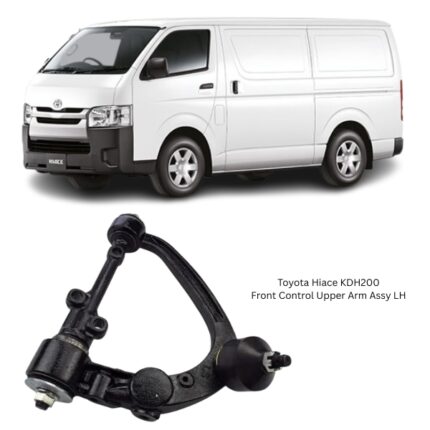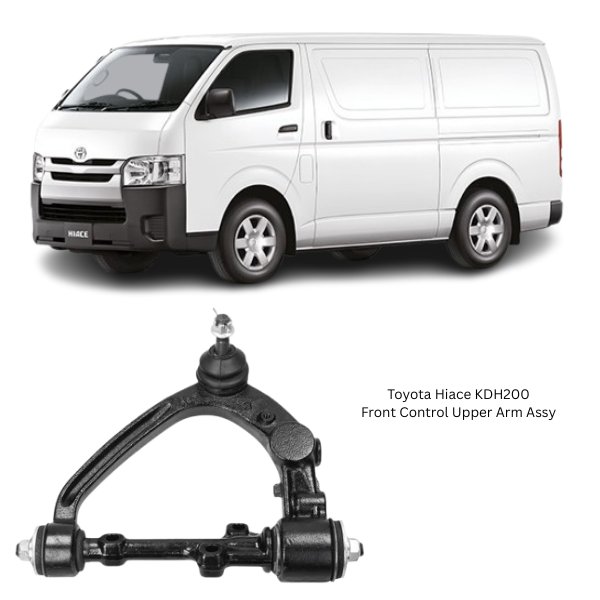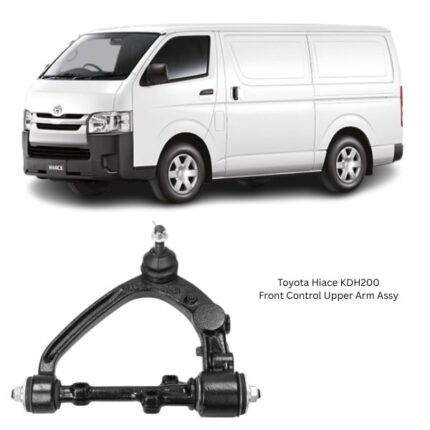Get Toyota Hiace KDH200 Front Control Upper Arm Assy RH 48066-29225 in Kenya
The Front Control Upper Arm Assembly RH (Right-Hand) is a key component of a vehicle’s front suspension system. Although less commonly recognized than the lower control arm, the upper control arm plays an equally crucial role in maintaining wheel alignment, enabling suspension articulation, and ensuring overall vehicle stability and ride comfort. Its design and function are especially vital in vehicles with double-wishbone or multi-link suspension setups.
1. What is the Front Control Upper Arm Assembly RH?
The Front Control Upper Arm Assembly RH refers to the upper control arm located on the front right side of a vehicle. It connects the vehicle’s chassis (or frame) to the steering knuckle via a ball joint and pivots on bushings or bearings. This arm supports and controls the up-and-down motion of the suspension and helps maintain the geometry of the front wheels during various driving conditions.
In most applications, the upper control arm is positioned above the lower control arm and works in tandem with it to stabilize the wheel and keep the tire in consistent contact with the road.
2. Core Components of the Upper Control Arm Assembly
The Front Control Upper Arm Assembly RH is composed of several integral parts:
-
Arm Body: Usually forged or stamped steel, or aluminum, engineered to be lightweight yet strong.
-
Bushings: These rubber or polyurethane components allow the control arm to pivot at its frame-mounted ends, absorbing noise and vibration.
-
Ball Joint: A spherical bearing connecting the arm to the steering knuckle, allowing for smooth articulation during turning and suspension movement.
-
Mounting Points: Bolt locations that secure the arm to the frame or subframe and allow proper alignment and movement.
3. Purpose and Function of the Front Upper Control Arm RH
a) Supports Suspension Geometry
The upper control arm maintains the angle of the wheels relative to the road (caster, camber, and toe). This ensures the vehicle handles predictably and safely.
b) Controls Vertical Movement
It allows the front wheels to move vertically when going over bumps or uneven surfaces, working with the lower control arm to form a stable suspension axis.
c) Enables Smooth Steering
Through the ball joint, the upper control arm facilitates proper steering articulation, ensuring that the wheel turns in response to driver input while staying vertically stable.
d) Maintains Tire Contact
By managing camber changes as the suspension compresses and rebounds, it helps the tires maintain maximum grip and contact with the road.
4. Advantages of a High-Quality Front Upper Control Arm Assembly RH
-
Enhanced Vehicle Stability: Maintains precise wheel alignment under all driving conditions, which improves cornering stability and control.
-
Reduced Tire Wear: Keeps the camber angle within factory specifications, helping avoid uneven tire wear.
-
Comfortable Ride: High-quality bushings and joints minimize road noise and vibration.
-
Improved Handling: A rigid and well-designed upper control arm enhances responsiveness and steering feel.
-
Durability: Strong materials and construction ensure resistance to bending, fatigue, and corrosion over time.
5. Common Symptoms of a Worn or Failing Upper Control Arm RH
Several signs can indicate a problem with the Front Control Upper Arm RH:
-
Clunking or Popping Noises – Often heard when going over bumps or turning, due to loose or damaged ball joints or bushings.
-
Uneven Tire Wear – If the upper control arm isn’t holding the wheel in proper alignment, tires may wear abnormally.
-
Steering Wander – The vehicle may drift or require frequent correction when driving straight.
-
Excessive Vibration – Particularly in the steering wheel, resulting from worn or damaged bushings.
-
Visible Damage – Cracks, rust, or bending in the arm, or degraded rubber in the bushings.
6. Causes of Upper Control Arm Assembly Wear or Failure
-
Aging Components: Over time, the rubber bushings can dry out and crack, and ball joints can lose lubrication or develop play.
-
Rough Driving Conditions: Repeated impacts from potholes, speed bumps, and off-road driving accelerate wear.
-
Heavy Loads: Overloading the front suspension stresses components and shortens lifespan.
-
Corrosion: Moisture and road salts can cause rust and weaken the arm structure, especially if uncoated.
-
Accidents or Curb Hits: Direct impacts can bend the arm or damage associated hardware.
7. Replacing the Front Upper Control Arm RH
Note: Always follow your vehicle’s specific service manual instructions or consult a professional mechanic.
Tools Required:
-
Jack and jack stands
-
Lug wrench
-
Wrenches and sockets
-
Ball joint separator or puller
-
Torque wrench
-
Penetrating oil (for rusted bolts)
Basic Replacement Procedure:
-
Lift the Vehicle Safely: Use a jack to raise the front end and secure it with jack stands.
-
Remove the Wheel: Provides access to the suspension components.
-
Disconnect the Ball Joint: Use a separator to release the ball joint from the steering knuckle.
-
Unbolt the Control Arm: Remove the bolts attaching the arm to the frame or subframe.
-
Install the New Arm: Position the replacement part and bolt it in place, torquing to the manufacturer’s specs.
-
Reconnect Ball Joint: Secure the ball joint to the knuckle and torque appropriately.
-
Reinstall the Wheel and Lower the Car
-
Perform Wheel Alignment: After replacing suspension parts, always do a professional alignment to restore correct geometry.
8. Maintenance Tips for Longevity
-
Regular Inspections: Check the arm, bushings, and ball joints for visible wear, cracking, or corrosion.
-
Grease Serviceable Joints: Some ball joints come with grease fittings – lubricate as recommended.
-
Avoid Rough Roads When Possible: Reduce stress on suspension parts by avoiding potholes or speed bumps.
-
Wash Undercarriage Periodically: Particularly important in areas with snow or salt use to prevent rust.
-
Timely Repairs: Address noise, vibration, or alignment issues early to prevent further damage.
9. Differences Between Upper and Lower Control Arms
While both the upper and lower control arms work together, they have distinct roles:
-
Lower Control Arms typically bear more of the vehicle’s weight and connect to the strut or shock absorber.
-
Upper Control Arms primarily help maintain camber and caster and ensure the vertical stability of the wheel during motion.
-
The upper arm is smaller and less load-bearing but critical for geometry control.
Follow us on Facebook for more parts.





Reviews
Clear filtersThere are no reviews yet.